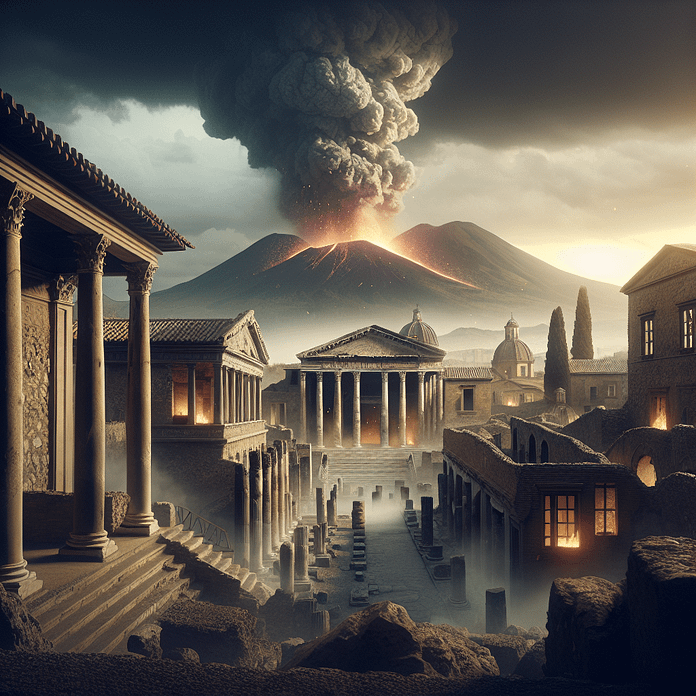
The eruption of Mount Vesuvius in AD 79 is often remembered as one of history’s most catastrophic natural disasters, a moment frozen in time that buried the Roman city of Pompeii under volcanic ash and pumice. What few realize, however, is that many of its inhabitants had a window of opportunity to escape—a critical five-hour period that separated survival from an agonizing death. Recent research has unveiled a minute-by-minute account of the eruption, shedding light on the tragedy that unfolded and the decisions that sealed the fate of thousands.
The first phase of Vesuvius’s eruption was not an immediate death sentence. Starting around midday on August 24, a towering column of volcanic gas, ash, and pumice shot into the stratosphere, creating what is known as a Plinian eruption. This phase, while fearsome, was not instantly lethal to those on the ground. Ash began falling like a gray snowfall, and lightweight pumice stones rained down. Many inhabitants managed to flee during these initial hours, making their way toward the coast or further inland. The city itself was still intact, though growing buried under layers of volcanic debris.
This early stage of the catastrophe offered a narrow but significant chance for survival. Yet, not everyone heeded the warning signs. For some, the eruption may have seemed like an inconvenience rather than a mortal threat. Others might have hesitated, unwilling to abandon their homes, businesses, or treasures. Archaeological findings suggest that many individuals stayed behind, either out of disbelief or a misplaced sense of security. Those who lingered would face the full fury of the volcano’s second, deadlier phase.
Sometime in the early evening, the eruption escalated dramatically. The towering plume of volcanic material, which had stood kilometers high, began to collapse under its own weight. This collapse triggered pyroclastic surges—searing clouds of hot gas, ash, and volcanic rock that tore down the mountainside at speeds exceeding 100 kilometers per hour. These surges were merciless, obliterating everything in their path and raising temperatures so high that human bodies in Pompeii were vaporized almost instantly. In some cases, the heat was so intense that it caused bodily fluids to boil and bones to shatter.
One particularly harrowing discovery is the evidence of victims being turned to glass. The extreme heat caused a process called vitrification, where human tissue and other organic matter were transformed into glass-like substances. This discovery underscores the unimaginable horror faced by those caught in the pyroclastic surges. It was not a slow suffocation under ash, as previously believed, but an instant and excruciating death brought on by temperatures exceeding 500 degrees Celsius.
The new minute-by-minute reconstruction of the eruption not only highlights the speed with which disaster struck but also emphasizes the pivotal role of human decision-making in times of crisis. The first five hours were a fleeting chance to escape an unstoppable force of nature. For those who acted quickly, survival was possible. For those who hesitated, the consequences were fatal.
The tragedy of Pompeii also serves as a stark reminder of the sheer power of nature and the vulnerability of even the most advanced civilizations. In AD 79, Pompeii was a thriving Roman city, complete with aqueducts, luxurious villas, bustling markets, and a well-organized social structure. Yet, in a matter of hours, it was reduced to an ashen graveyard. This dichotomy between human achievement and nature’s overwhelming power is a sobering lesson that echoes across the centuries.
Archaeological evidence continues to uncover new details about the lives and deaths of Pompeii’s residents. From the remains of meals left uneaten to the positions of bodies frozen in their final moments, each discovery adds another layer to the story. Recent excavations have even revealed new buildings and artifacts, offering a glimpse into the daily life of a city that was abruptly silenced.
The story of Pompeii is not just one of destruction but also of preservation. The volcanic ash that buried the city also protected it from time, leaving behind an unparalleled archaeological record. Frescoes, mosaics, tools, and even graffiti have been found remarkably intact, providing a window into Roman life that is unmatched anywhere else. Yet, beneath this remarkable preservation lies the sobering reality of a catastrophe that claimed thousands of lives, many of whom had the chance to escape but did not.
The recent findings about the eruption’s timeline bring a new level of detail to this ancient tragedy, offering a clearer understanding of what happened and when. They also raise questions about human behavior in the face of disaster—a theme that remains as relevant today as it was two millennia ago. The story of Pompeii is not just a historical event but a timeless lesson in the unpredictability of nature and the importance of seizing opportunities when they arise.


